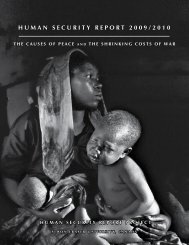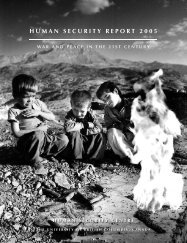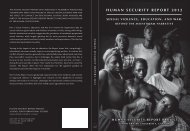H U M A N S E C U R I T Y B R I E F 2 0 0 6
H U M A N S E C U R I T Y B R I E F 2 0 0 6 - Human Security Report ...
H U M A N S E C U R I T Y B R I E F 2 0 0 6 - Human Security Report ...
Create successful ePaper yourself
Turn your PDF publications into a flip-book with our unique Google optimized e-Paper software.
tance increases the killing capacity of the warring parties ininternationalized intrastate wars.Extra-state conflicts are essentially the wars of colonialliberation. They were fought for just three decades followingthe end of World War II. However, at times in the late 1940sand 1950s they accounted for 20% to almost 50% of all statebasedconflicts. Furthermore, from 1954 to 1961 extra-stateconflicts were, on average, the deadliest form of armed conflict.France’s colonial wars in Indochina and Algeria were the mostdeadly in the period 1950 to 2005.Non-state Armed ConflictNon-state conflicts are those fought between militias, rivalguerrilla groups, clans, warlords, or organized communalgroups, without the involvement of a government. 19 Althoughnon-state conflicts are about as prevalent as state-basedconflicts, they are not recorded in the annual war countsthat are published in the Journal of Peace Research nor in theStockholm International Peace Research Institute’s SIPRIYearbook, both of which rely on UCDP data.Figure 1.4 Average Number of Battle Deaths perState-based Armed Conflict, per Year, 1950-2005*non-state conflict was just 82; for state-based conflicts itwas 388.Non-state conflicts also tend to be relatively short induration. Just over a quarter of the 25 non-state armedconflicts in 2005 were also active in 2004. Of these, onlyone—that between the Revolutionary Armed Forces (FARC)and the United Self-Defence Forces (AUC) in Colombia—hasbeen active each year since 2002. Given their low death tollsand short duration, it is not surprising that many non-stateconflicts are so little known outside the countries in whichthey occur. 21Non-state armed conflicts tend to occur in countrieswith weak governments that have little capacity for maintaininginternal security. In 2005, as has been the case in each ofthe four years that data have been collected, over half of theworld’s non-state armed conflicts occurred in sub-SaharanAfrica. The region has nevertheless seen a 42% decrease inthese conflicts over the past four years.Sub–Saharan Africa accounted forthe majority of deaths from non–state conflict in 2005.70(‘000)6050403020100Internationalized intrastateIntrastate conflictsInterstate conflictsExtra-state conflictsTotal1950–59 1960–69 1970–79 1980–89 1990–99 2000–05Data source: UCDP/PRIO and Lacina & Gleditsch 20Interstate wars, though relatively few in number,are by far the deadliest form of conflict.*Fatality figures are “best estimates.”Concerned that this omission created a very incompletepicture of armed conflict around the world, the HumanSecurity Centre commissioned UCDP to collect data onnon-state conflicts for the Human Security Report 2005. Thischapter presents new non-state conflict data for 2004 and2005 that complement the material published in 2005.Non-state conflicts are significantly less deadly thanstate-based conflicts. In 2005 the average death toll for eachFigure 1.5 shows the regional distribution of non-stateconflicts. Both the concentration of these conflicts in Africaand their sharp decline since 2002—from 24 to 14 in 2005—are clearly evident in the table, which also reveals that Europeis the only region in this period to have experienced no nonstateconflicts.Non-state conflicts tend to be concentrated not only inthe sub-Saharan African region, but also within particularAfrican countries. In 2005 five African countries accountedfor 15 of the 25 non-state conflicts: Somalia experienced sixconflicts; Nigeria three; while Ethiopia, the Ivory Coast, andSudan had two each.Battle-death Trends in Non–state ConflictsFigure 1.6 shows that sub-Saharan Africa accounted for themajority of deaths from non-state armed conflict in 2005—and indeed in all four years since data collection began. Butthere has been a dramatic 80% decline in the death toll inthe region since 2002. Central and South Asia experienced aneven greater decline in death toll—dropping some 88%. (Notethat the Sudan/Darfur data are included in the Middle Eastand north Africa region, not sub-Saharan Africa.)H U M A N S E C U R I T Y B R I E F 2 0 0 6 9






